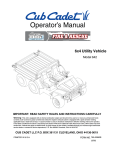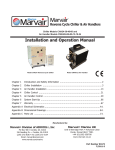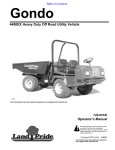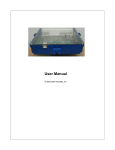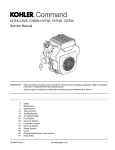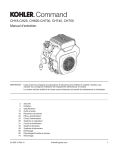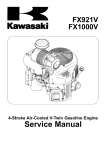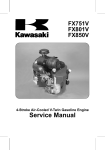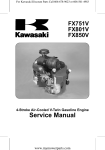Download Cub Cadet 435A Operator`s manual
Transcript
Safety • Assembly • Operation • Tips & Techniques • Maintenance • Troubleshooting • Parts Lists • Warranty OPERATOR’S MANUAL 4x2 Utility Vehicle — Models 435A & 435D IMPORTANT READ SAFETY RULES AND INSTRUCTIONS CAREFULLY BEFORE OPERATION Warning: This unit is equipped with an internal combustion engine and should not be used on or near any unimproved forest-covered, brushcovered or grass-covered land unless the engine’s exhaust system is equipped with a spark arrester meeting applicable local or state laws (if any). If a spark arrester is used, it should be maintained in effective working order by the operator. In the State of California the above is required by law (Section 4442 of the California Public Resources Code). Other states may have similar laws. Federal laws apply on federal lands. A spark arrester for the muffler is available through your nearest engine authorized service dealer or contact the service department, P.O. Box 361131 Cleveland, Ohio 44136-0019. CUB CADET LLC, P.O. BOX 361131 CLEVELAND, OHIO 44136-0019 PRINTED IN U.S.A. FORM NO. 769-01878A 2/3/2006 This Operator’s Manual is an important part of your new utility vehicle. It will help you operate and maintain the unit for best performance. Please read and understand what it says. Table of Contents Safe Operation Practices ................................... 4 Know Your Utility Vehicle ................................... 6 Operating Your Utility Vehicle ............................ 9 Servicing Your Utility Vehicle ........................... 12 Service Chart .................................................... 16 Accessories ...................................................... 16 Specifications ................................................... 17 Shift Fault Codes .............................................. 18 Troubleshooting................................................ 20 Warranty ............................................................ 22 Finding and Recording Model Number BEFORE YOU START OPERATING YOUR NEW EQUIPMENT... please locate the model plate on the equipment and copy the information to the sample model plate provided to the right. Model Number:_________________________ Serial Number:_________________________ You can locate the model plate on the vehicle under the operator’s seat. Flip the seat forward to view model plate. This information will be necessary to use the manufacturer’s web site and/or help from the Customer Support Department or an authorized service dealer. CUB CADET LLC P. O. BOX 361131 www.cubcadet.com CLEVELAND, OH 44136 DEALER LOCATOR PHONE NUMBER: 877-282-8684 Customer Support For Customer Support please contact the retailer from which the unit was purchased, or use one of the methods below to find a service dealer nearest you. If you have difficulty assembling this product or have any questions regarding the controls, operation or maintenance of this unit, contact the retailer from which you purchased this vehicle. To find a Cub Cadet Dealer nearest you choose from the options below: 1. Visit www.cubcadet.com to search for a service dealer nearest you using your zip code. You will also find many useful suggestions and tips. 2. Phone our dealer locator number toll free at 1-877-282-8684. 3. The engine manufacturer is responsible for all engine-related issues with regards to performance, power-rating, specifications, warranty and service. Please refer to the engine manufacturer’s Owner’s/Operator’s Manual, packed separately with your unit, for more information. 2 3 WARNING 777S32162 To Avoid An Accident And Injury + 2258 Lb. / 1026 KG 1,200 Lb. DIE CUT DIE CUT DIE CUT DIE CUT DIE CUT P 777D09517 777I22267 800 Lb. / 362 KG 1058 Lb. / 481 KG 777I22099 �������������� or anywhere other than seats. • No riders in cargo box • Spread load evenly. Secure load to prevent movement. • Go slow. Avoid sudden starts and stops which could cause load to shift. • Do not load above height of this panel. Load could shift forward injuring driver or passenger. CARGO BOX LOAD CAPACITY: MAX 800 Lb. WARNING 777S32360 P PARKING BRAKE 777I22097 777I22134 Always Set • If Shift Fault Occurs Turn Key To Off Position. Parking • Restart Unit. Brake When • If Fault Continues Consult Stopped. Owners Manual For Details. 777I22131 777I22567 ���������� (QTY 2) 777D08739 777D09519 777I22123 ��������������� other than seats. • No riders in the cargo box or anywhere • Only one person in each seat. RIDERS CAN FALL OFF AND BE SERIOUSLY INJURED OR KILLED WARNING 777S32361 �������������������������������������� • Only one person in each seat. • No other riders permitted. • Keep hands and feet inside vehicle during operation. • Do not operate on slopes greater than 15º. • Drive slowly when turning, on rough ground, or carrying a cargo load. • Spread load evenly in cargo box. Do not exceed load capacity specified on cargo box label. • Secure load to prevent movement. FALLING OFF OR ROLLOVER MAY CAUSE SERIOUS INJURY OR DEATH MAX 15º • This is an off-road utility vehicle. Do not operate on public highways. It handles and maneuvers differently than a normal passenger car. Sharp, high speed turns or abrupt maneuvers can cause vehicle to roll over or go out of control. • Handling and maneuvering characteristics of vehicle change depending upon cargo load. Heavy loads will affect steering, braking, stability and overall handling of vehicle. • Read and understand operator's manual before operating vehicle. WARNING 777S32158 CENTER AUX 30 AMP C (QTY2) 777D09521 LIGHTS / SWITCHES LS 12V/40A RELAYS ONLY F1 CENTER ACCESORY F2 L1 FRONT ACCESORY RELAY CENTER R1 BED LIFT L2 R2 REAR ACCESORY TOP 777I22113 LIGHTS / SWITCHES FRONT POWER FUEL SENDER FUEL PUMP 5 AMP 5 AMP POINT 10 AMP 20 AMP REAR 4X2 JUMPER 5 AMP FRONT AUX 30 AMP CENTER POWER POINT 10 AMP BED LIFT 30 AMP HORN 7.5 AMP 6X4 JUMPER 5 AMP REAR AUX 30 AMP 777I22044 777D09523 (QTY2) 777D09520 (QTY2) 777D09522 ����������������������������������� �������������� ����������������������������������������������������������������� �������������������������������������������������������� �������������������� ������������������������������������������� ��������������������������� � ����������������������������� � �������������������������������������������� ���������������������������������������������� � ���������� �������������������������������� � ���������������������������� ������������������������������������������������� � �������������������� � ����������������������������������� � ���������� ��������� 777S32515 �������������� 777D09518 ��������� • Do not tow more than 900 Lb. rolling weight (i.e., trailer plus cargo). • Spread load evenly. Never exceed 100 lb. tongue weight. • Go slow and use extra care when towing. Allow for increased braking distance. • Do not tow heavy loads on slopes over a 5º incline. S32162 1 Labels To order any of these labels, contact your nearest Cub Cadet service dealer or call 1-877-282-8684. 2 Safe Operation Practices WARNING This symbol points out important safety instructions which, if not followed, could endanger the personal safety and/or property of yourself and others. Read and follow all instructions in this manual before attempting to operate or service this vehicle. When you see this symbol - heed its warning. Your Responsibility Restrict the use of this power machine to persons who read, understand and follow the warnings and instructions in this manual WARNING: Engine Exhaust, some of its constituents, and certain vehicle components contain or emit chemicals known to State of California to cause cancer and birth defects or other reproductive harm. DANGER: This vehicle is designed to be operated according to the rules for safe operation in this manual. As with any type of vehicle, carelessness or error on the part of the operator can result in serious injury. Failure to observe the following safety instructions could result in serious injury or death. General Operation 20. Never leave vehicle unattended with the key in the ignition. Always turn key to the “Stop” position, set the parking brake and remove key. 21. Check overhead clearances carefully before driving under low hanging tree branches, wires, etc., where the operator may be struck or pulled from the unit, which could result in serious injury. 22. Improper use of the vehicle or failure to properly maintain it could result in decreased vehicle performance or personal injury. 23. Engine must be stopped when cleaning, servicing, adjusting, repairing, or installing attachments on utility vehicle. 24. After striking foreign objects, stop the unit and shut off the engine. Inspect for damage and repair the damage before restarting and operating equipment. 25. Do not start or operate vehicle in an inside area, unless it is adequately ventilated. Engine exhaust contains carbon monoxide fumes, which are very poisonous and can be deadly. 26. Do not change engine governor setting or over speed the engine. The governor is set at the factory for safe operating speed. 27. Assure safety interlock switch is adjusted correctly so engine cannot be started unless gearshift is in the neutral position. 28. Do not touch engine or muffler while engine is running or soon after it is stopped. They will be hot and can cause a burn. 29. Always inspect your vehicle each time you use it to make sure it is in safe operating condition. Always follow the inspection and maintenance procedures and schedules described in this manual. 30. If situations occur which are not covered in this manual, use care and good judgement. Contact your local service center or call toll free 1-877-282-8684 for assistance and the name of your nearest service center. 1. Read, understand, and follow all instructions on the vehicle and in the manual before attempting to operate or service. Keep this manual in a safe place for future and regular reference and for ordering replacement parts. 2. This is an off-road utility vehicle and it should not be operated on public highways. Know and comply with all laws and regulations governing the use of off-highway vehicles in your area. 3. This vehicle handles and maneuvers differently than a normal passenger car. Sharp high speed turns and abrupt maneuvers can cause vehicle to roll over or go out of control. Slow down when turning and avoid abrupt maneuvers. 4. Handling and maneuvering characteristics of vehicle change depending upon cargo load. Heavy loads affect steering, braking, stability, and overall handling of vehicle. 5. Be familiar with all instructions and controls and their proper operation before starting vehicle. 6. Never allow adults to operate this vehicle without proper instruction. 7. Never allow children under 16 years old to operate this vehicle. Children 16 years old and over should read and understand the operation instructions and safety rules in this manual and should be trained and supervised by a parent. 8. Watch for traffic when operating near or crossing roadways. This vehicle is not intended for use on any public roadway. 9. Do not operate this vehicle while under the influence of alcohol or drugs. 10. Never carry more than one passenger. This vehicle is designed to carry the driver and one passenger only. No riders are allowed in cargo box or anywhere else on vehicle. 11. Keep all body parts (i.e. head, arms, hands, legs, feet) inside vehicle when vehicle is in motion. 12. Always remain seated and keep both hands on the steering wheel when driving the vehicle. 13. Sit on the center of the seat and keep both feet within the foot platform perimeter. Clean foot platform if dirty and remove any debris from around foot controls, e.g. brake pedal. 14. Do not misuse the utility vehicle. It is an utility vehicle, not a recreation vehicle or toy. Recreational riding can lead to accidents, severe bodily injury or death. 15. Inspect area around vehicle before moving, especially in reverse. Back up slowly. Always look down and behind before and while backing to avoid a back-over accident. Keep bystanders out of area. 16. Avoid driving through water, since loss of control may occur. Drive belt may slip if exposed to water thus reducing vehicle pulling power and stopping vehicle entirely. 17. Always use vehicle lights while operating in low light situations. 18. Do not mount or leave vehicle while it is in motion or in actual operation. 19. Avoid sudden starts, stops, or turns and always use a level turn-around area. Slope Operation Slopes are a major factor related to loss of control and rollover accidents, which can result in severe injury or death. If a slope is steeper than a 15° incline, do not operate this unit on that area. Exercise extreme caution while operating on slopes. DO: 1. Travel straight up and down slopes, not across. Exercise extreme caution when changing direction on slopes. 2. Travel slowly while on a slope. Always keep the forward speed limited when going down slopes to take advantage of the motor braking action. 3. Keep all movement on the slopes slow and gradual. Avoid starting or stopping on a slope. 4. Avoid slopes with slippery, loose, or bumpy surfaces as they are especially hazardous. 5. Use extra care while carrying cargo. It may affect the stability of the vehicle. Spread the load evenly or tie down. 4 Do Not: 1. Do not travel near drop-offs, ditches or embankments. The vehicle could suddenly turn over if a wheel is over the edge of a cliff, ditch, or if an edge caves in. 2. Do not stop or start suddenly when going uphill or downhill. Be especially cautious when changing direction on slopes. 3. Do not turn sideways to the hill. The vehicle may roll over. If you must turn, go slow and do so carefully and gradually. 4. Do not carry cargo on steep slopes or tow loads. Children 1. Tragic accidents can occur if the operator is not alert to the presence of children. Children are often attracted to the vehicle. They do not understand the dangers. Never assume that children will remain where you last saw them. Avoid run over accidents. a. Keep children out of the immediate area of the vehicle and in watchful care of a responsible adult other than the operator. c. Do not allow rear wheels to hang over the edge of a drop-off when raising cargo box. The load in the cargo box may shift causing the vehicle to tip over backwards. Towing 1. Always use an approved hitch and hitch point provided on the utility vehicle. 2. Do not tow more than 900 lb. (454 kg) rolling weight (i.e. trailer plus cargo). 3. Never load more than 100 lb. (45.5 kg) tongue weight on tow bracket provided. 4. Go slow and use extra care when towing a trailer. Allow for increased braking distance. Load trailer properly. 5. Do not tow heavy loads on slopes greater than 5° incline. When going downhill or turning, the extra weight tends to push the tow vehicle and may cause you to loose control (i.e. braking and steering ability are reduced, towed equipment may jack-knife and cause utility vehicle to overturn). d. Never carry small children, they may fall off and be seriously injured or interfere with safe vehicle operation. e. Use extreme care while approaching blind corners, doorways, shrubs, trees or other objects that may block your vision of a child who may run into the path of the vehicle. f. Safe Operation Practices Service b. Be alert and turn the vehicle off if a child enters the area. c. Before and while backing, look behind and down for small children. 2 Safe Handling Of Gasoline: 1. To avoid personal injury or property damage use extreme care in handling gasoline. Gasoline is extremely flammable and the vapors are explosive. Serious personal injury can occur when gasoline is spilled on yourself or your clothes which can ignite. Wash your skin and change clothes immediately. a. Use only an approved gasoline container. Remove key when vehicle is unattended to prevent unauthorized operation. b. Never fill containers inside a vehicle or on a truck or trailer bed with a plastic liner. Always place containers on the ground away from your vehicle before filling. 2. Never allow children under 16 years old to operate this vehicle. Children 16 years old and over should read and understand the operation instructions and safety rules in this manual and should be trained and supervised by a parent. 3. Do not let children ride in the cargo box, in the driver’s or passenger’s lap or anywhere other than the passenger seat. Never give small children a ride; not even in the passenger seat. They may fall off. c. When practical, remove gas-powered equipment from the truck or trailer and refuel it on the ground. If this is not possible, then refuel such equipment on a trailer with a portable container, rather than from a gasoline dispenser nozzle. d. Keep the nozzle in contact with the rim of the fuel tank or container opening at all times until fueling is complete. Do not use a nozzle lock-open device. Cargo Box Loading/Operation e. Extinguish all cigarettes, cigars, pipes and other sources of ignition. 1. Do not exceed vehicle’s Total Load Capacity rating of 1,200 lb. This includes operator, passenger, accessories, and cargo. 2. Do not exceed 800 lb. load in cargo box. 3. Spread load evenly and secure to prevent movement. 4. Do not load above height of cargo box front panel. Load could shift forward and injure driver or passenger. 5. Avoid loads which exceed the physical dimensions of cargo box. 6. Go slow. Heavy loads will affect steering, braking, stability, and overall handling of the vehicle. Limit loads to those that can be safely controlled. 7. Avoid sudden starts, stops, and turns which could cause load to shift. f. Never fuel machine indoors. g. Never remove gas cap or add fuel while the engine is hot or running. Allow engine to cool at least two minutes before refueling. h. Never over fill fuel tank. Fill tank to no more than ½ inch below bottom of filler neck to allow space for fuel expansion. Cargo Box Lift i. Replace gasoline cap and tighten securely. j. If gasoline is spilled, wipe it off the engine and equipment. Move unit to another area. Wait 5 minutes before starting the engine. k. To reduce fire hazards, keep machine free of grass, leaves, or other debris build-up. Clean up oil or fuel spillage and remove any fuel soaked debris. 1. Stop vehicle on level ground and set Parking Brake before raising cargo box. 2. On manual lift units, unload cargo box before raising cargo box. 3. Do not operate vehicle with cargo box in raised position. 4. Do not operate vehicle with cargo box latch unlatched. Always re-latch upon manually lowering cargo box. When using optional electric lift: a. Stay in driver’s seat. l. b. Keep body parts away from cargo box and keep all bystanders away. 5 Never store the machine or fuel container inside where there is an open flame, spark or pilot light as on a water heater, space heater, furnace, clothes dryer or other gas appliances. WARNING This symbol points out important safety instructions which, if not followed, could endanger the personal safety and/or property of yourself and others. Read and follow all instructions in this manual before attempting to operate or service this vehicle. When you see this symbol - heed its warning. Your Responsibility Restrict the use of this power machine to persons who read, understand and follow the warnings and instructions in this manual 3 Know Your Utility Vehicle NOTE: Reference to right or left hand side of the utility vehicle is observed from the operating position. Know Your Utility Vehicle P Differential Lock Switch Choke Knob Parking Brake Latch Figure 1 WARNING Never leave a running machine unattended. Always set parking brake, stop engine and remove key to prevent unintended starting. Brake Pedal Read this operator’s manual, safety labels, and operating instructions on the vehicle before operating. Compare the illustrations in this manual with your unit to familiarize yourself with the location of various controls and adjustments. Reference to the right or left hand side of unit is observed from the operating position. Save this manual for future reference. The brake pedal is located on the left side of the floor beneath the dash panel. Remove foot from accelerator pedal apply pressure to the brake pedal evenly until vehicle slows down and stops. See Figure 2. Parking Brake Latch IMPORTANT: Read the Kohler Engine operator’s manual before operating this vehicle to familiarize yourself with the engine controls and adjustments. The parking brake latch is located on the dash panel to the right of the steering wheel. It holds the brake in the engaged position for parking. See Figure 1. NOTE: Before operating your vehicle, follow the starting instructions in the Operating Section and check tire pressure per the recommendations in the Servicing section. To engage the parking brake, push brake pedal down firmly, pull out on the parking brake latch, and release foot from brake pedal. Brake pedal will stay down and parking brake light on dash will come on to indicate parking brake is engaged. Accelerator Pedal The accelerator pedal is located on the right side of the floor beneath the dash panel. Depressing the accelerator pedal will move the vehicle in the direction selected on the gearshift. As the pedal is depressed, speed will increase to the maximum selected range. Releasing the pedal reduces the speed, but does not stop the vehicle. The brake must be applied to stop vehicle. See Figure 2. To release parking brake, push down on brake pedal and parking brake latch will release. Ignition Switch WARNING: Never leave a running machine unattended. Always set parking brake, stop engine and remove key to prevent unintended starting. Accelerator Pedal The ignition switch is located on the right side of the dash panel. To start the engine, insert the key into the ignition switch and turn clockwise to the START position. Release the key into the Run position once engine has fired. See Figure 3. Brake Pedal NOTE: The shift controller will return the transmission to neutral when the key is turned off. If the lever under the cargo box is not in neutral it must be manually returned to neutral to start engine. See Page 9 for instructions on checking and resetting the lever on the transmission. Refer to Starting The Engine in the Operation Section of this manual for detailed starting instructions Figure 2 6 Hour Meter Rear Power Outlet Switch (Optional) P P Gear Lights Figure 4 Cargo Box Electric Lift Switch (Optional) Key Switch 12-Volt Power Outlet Figure 3 Horn Switch (Optional) The horn switch is located on the right side of the dash panel. Push button to activate horn. Gear Lights The gear lights are located on the right side of the dash panel. See Figure 3. Once a gear is selected, a gear light, or a combination of gear lights, will illuminate. If the vehicle has not shifted properly, or there is a shifting issue, the lights will flash for 5 seconds and an audible tone will sound. During this time a shift will not be allowed, however, once the lights stop flashing, shifting will be allowed. Refer to SECTION 9: Electric Shift Fault Codes and/or SECTION 10: Troubleshooting to determine the failure mode. Hour Meter 12V Power Outlet The 12V power outlet is located on the right side of the dash panel. It is used for the convenience of plugging in accessories that require a power source with a maximum load of 5 amps at 12 volts. See Figure 3. Cargo Box Electric Lift Switch (Optional) If equipped, the cargo box electric lift switch is located on the right side of the dash panel. It activates lift to raise and lower cargo box. See Figure 3. Rear Power Outlet Switch (Optional) If equipped, the rear power outlet switch is located on the right side of the dash panel. It turns power on and off for the rear outlet. See Figure 3. Warning Light Cluster The warning light cluster is located in the middle of the dash panel. See Figure 4. There are four warning lights: alternator discharge light (Battery), parking brake light, engine oil pressure light, and low fuel light. The hour meter is located in the center of the warning light cluster. It reads the elapsed time engine has run. See Figure 4. Choke Knob The choke knob is located on the left side of the dash panel. The choke is used when starting a cold engine. It enrichens the fuel mixture for cold weather starting. See Figure 1. Differential Lock Switch The differential lock knob is located on the left side of the dash panel. When pulled, the differential knob locks the differential so both drive wheels will pull equally when rear wheels start to slip. To disengage, push the differential lock knob in. See Figure 1 for location. Cup Holders The cup holders are located between the seats. They are designed for the use of non-alcoholic beverages. WARNING: Never operate this vehicle while under the influence of alcohol or drugs. Doing so can result The engine oil pressure light activates when engine has low oil pressure. The alternator discharge light will indicate that the alternator is not charging. The low fuel light activates when fuel is low in tank. The parking light indicates that the parking brake is engaged. Gearshift Switches The gearshift switches are located on the right side of the dash panel next to the gear lights. When pushing the appropriate switch for forward, neutral, or reverse, the brake pedal must be depressed. See Figure 2 for Brake Pedal location. 7 3 Know Your Utility Vehicle WARNING Never leave a running machine unattended. Always set parking brake, stop engine and remove key to prevent unintended starting. Never operate this vehicle while under the influence of alcohol or drugs. Doing so can result in serious personal injury or death. NOTE: The shift controller will return the transmission to neutral when the key is turned off. If the lever under the cargo box is not in neutral it must be manually returned to neutral to start engine. 3 Know Your Utility Vehicle locked position prior to operation and do not try to adjust the seat position while operating the vehicle. in serious personal injury or death. Fuel Shut Off Valve Cargo Box The fuel shut off valve is located under the seat and it is strapped onto the fuel tank. It controls fuel to the engine. To turn fuel off, turn knob so indicator is down. To turn fuel on, turn knob to the up position. See The cargo box is raised by a gas spring. Manually remove the contents of the cargo box before lifting the cargo box. Push the release latch down and lift up the cargo box. Once the cargo box is in the raised position, access to the engine is possible. If equipped with a electrical lift, the cargo box can be raised to dump cargo. See Figure 7. IMPORTANT: Do not exceed the vehicle’s Total Load WARNING Make sure seat is in locked position prior to operation and do not try to adjust the seat position while operating the vehicle. IMPORTANT: Do not exceed the vehicle’s Total Load Capacity of 1,200 lb., which includes driver, passenger, accessories, and cargo. Do not exceed 800 lb. in the cargo box. Fuel Shut-off Valve Figure 5 Figure 5. Adjustable Seat Lever The adjustable seat lever is located beneath the driver’s seat on the front side and it is used to move the seat forward and backward. See Figure 6. Figure 7 Slide the lever to the left and push the seat forward or back to the desired position. Release the lever so that it locks the seat in place. Capacity of 1,200 lb., which includes driver, passenger, accessories, and cargo. Do not exceed 800 lbs. in the cargo box. Tailgate WARNING: Make sure seat is in The tailgate can be hinged at the top or the bottom Figure 6 Figure 8 depending on how you release the holding pins. If you 8 Operating Your Utility Vehicle WARNING: This is an off-road utility vehicle and it should not be operated on public highways. Know and comply with all laws and regulations governing the use of off-highway vehicles in your area. IMPORTANT: Before starting the engine read this manual and the Kohler Engine manual thoroughly to understand all instructions. 4 Operation WARNING: Do not run an engine in an enclosed area. Move the vehicle to an outside area before running the engine. IMPORTANT: Tires are shipped over-inflated. Reduce inflation pressure in all tires to approximately 5 -6 psi. Check Neutral Safety Switch 4. Pull out the choke knob if engine is cold. 1. Sit in the operator’s seat and place key switch in STOP position. 5. Turn key to the START position. 2. Engage the parking brake, raise and secure cargo box, and move lever to the forward position. See Figure 12. 7. If engine does not start, wait a few seconds and repeat procedures. 6. Release key to the RUN position when engine starts. 8. After engine starts, push in choke knob. 9. Release parking brake. IMPORTANT: DO NOT run the starter continuously for more than 5 seconds, otherwise the battery may discharge quickly. NOTE: If engine surges after starting while idling or driving at a low speed, apply choke as needed until engine has warmed up. IMPORTANT: Do not operate the engine under full load until engine has warmed up. Stopping Engine 1. To stop utility vehicle, release accelerator pedal and depress brake pedal until vehicle comes to a complete stop. Figure 12 3. Sit back down in operator’s seat and move key switch to START position. The engine should NOT crank. 2. Put unit back into neutral. 3. Lock parking brake and turn key switch to STOP position. 4. Remove the key when not in use. 4. Turn key switch to STOP and move lever to the reverse position. WARNING: The vehicle will roll if the parking brake is not engaged and locked. 5. Sit back down in operator’s seat and move key switch to START position. The engine should NOT crank. 6. Turn key switch to STOP. 7. Lower and re-latch the cargo box. 8. Keep engine compartment clean and be sure fan or flywheel screens remains installed and clean. Starting Engine Driving Utility Vehicle 1. Make sure front wheels are turned to the desired direction. 2. Depress brake pedal to release parking brake. 3. To avoid damaging transmission, depress brake pedal fully and make sure vehicle is completely stopped before shifting into Forward or Reverse. WARNING: Do not stop or start suddenly when going uphill or downhill. Be especially cautious when changing direction on slopes. Apply brakes when going down slopes to maintain control of vehicle. 1. Sit in the operator’s seat and place key switch in STOP position. 2. Lock parking brake. 3. Put into neutral. 9 WARNING This is an off-road utility vehicle and it should not be operated on public highways. Know and comply with all laws and regulations governing the use of off-highway vehicles in your area. Do not run an engine in an enclosed area. Move the vehicle to an outside area before running the engine. Do not stop or start suddenly when going uphill or downhill. Be especially cautious when changing direction on slopes. Apply brakes when going down slopes to maintain control of vehicle. 4 Operation 4. Release brake pedal and apply pressure to the accelerator pedal. Manual Lift 1. Park the vehicle safely on level ground and set parking brake. 5. Release accelerator and apply brake pedal evenly and firmly to slow down or stop. 2. Empty cargo by hand and unlatch cargo box by pushing down on the cargo latch. See (A) Figure 13. Engaging Differential Lock The Differential Lock Switch is located on the left side of the dash panel. See Figure 13. 1. To engage, stop or slow vehicle speed and pull knob. The differential will then lock giving continuous power to both rear wheels. While in the pulled position, the differential lock will remain engaged. 3. While holding the latch down, lift the cargo box (B). 4. Lower and allow bed to re-latch cargo box before operating unit. Differential Lock Knob A B WARNING To avoid transaxle damage, injury, or turf damage, go slow when operating vehicle with differential lock engaged as steering response is noticeably reduced. To prevent the possibility of bodily injury from unintentional lowering of the cargo box, be sure vehicle is on a level and stable surface and parking brake is locked before raising cargo box. Figure 14 Electric Lift (Optional) Figure 13 1. Park the vehicle safely and turn key to the RUN position. IMPORTANT: Engage the differential when the left and right side wheels are turning at slightly different speeds. WARNING: To avoid transaxle damage, injury, or turf damage, go slow when operating vehicle with differential lock engaged as steering response is noticeably reduced. Disengaging Differential Lock 2. Raise cargo box by pressing and holding top of electric lift switch. Release switch when box is at desired dump height or when maximum height is reached. NOTE: A ratcheting noise will indicate cargo box is at full extension. The same noise will also be heard when cargo box is at the full down position. If lift capacity of the power lift is exceeded, a ratcheting will also be heard. 3. To lower cargo box, push on bottom of electric lift switch. Turn ignition switch to the STOP position. 1. To disengage the differential lock, simply push the knob in and the lock will disengage. Torque must be equal on both axles for differential lock to release. It is best to slow down and drive straight ahead at a constant speed when disengaging the differential. Raising & Lowering Cargo Box WARNING: To prevent the possibility of bodily injury from unintentional lowering of the cargo box, be sure vehicle is on a level and stable surface and parking brake is locked before raising cargo box. 10 Towing Loads Dumping Load From Cargo Box WARNING: To help prevent personal injury due to loss of control or tipping, always tow a load slowly enough to maintain control. 1. Back up the vehicle to the dump site and apply parking brake. 2. Unhook the tailgate from cargo box. 3. If using an electric lift, raise cargo box to dump load and lower box when empty. WARNING: The center of gravity changes as a loaded cargo box is raised. Do not allow rear wheel to hang over the edge of a loading dock or ravine. The cargo box weight may shift over center and vehicle could tip over backwards. WARNING: A loaded cargo box can be very heavy. Do not attempt to dump a loaded cargo box unless vehicle is equipped with an electric lift option. IMPORTANT: If dumping by electric lift, stop immediately if actuator clutch slippage occurs. Lower cargo box completely and remove excess load by hand before dumping. 4. Reconnect the tailgate to the cargo box. Do not drive the vehicle with cargo box in the raised position. Loading the Cargo Box WARNING: The utility vehicle may become unstable if the cargo box is loaded incorrectly. Avoid loose and shifting loads or uneven loading of material. 1. Verify cargo box is latched before loading. 2. Securely anchor all loads in cargo box and do not load beyond maximum capacity. 1. Do not tow a load that exceeds 900 lbs.(454.5 kg) rolling weight (i.e. trailer plus cargo) and never exceed 100 lbs. (45.5kg) tongue weight. 4 Operation 2. Go slow when towing a heavy load. Allow for increased braking distance. Tow load at a speed slow enough to maintain control. 3. Do not tow on slopes greater than 5°. 4. Be particularly cautious when towing down even a gradual slope or turning. The extra weight tends to push the tow vehicle and may cause you to lose control (braking and steering ability are reduced; towed equipment may jack-knife). IMPORTANT: Extreme angles such as high railroad crossings can place high bending loads on hitch connection. If traversing terrain where these conditions exist, use of a ball or pintle type hitch is recommended. 5. Always use approved hitch and hitch point provided for the utility vehicle. Do not modify the hitch in any way. Transporting Vehicle IMPORTANT: Never tow the vehicle. Transaxle damage will occur if vehicle is towed. Haul the vehicle on a heavy-duty trailer or on a full-size truck. 1. Once the utility vehicle is loaded onto the trailer or truck, leave transaxle gearshift lever in forward or reverse. 3. The maximum box capacity is 800 lbs. (362.9 kg). 2. Apply parking brake and turn fuel shut-off valve to OFF position during transport. 4. When loading objects into vehicle, be sure load is securely anchored and evenly distributed in cargo box. 3. Fasten vehicle to trailer or truck with straps, chains, or cables. 5. Do not load above height of cargo box front panel. Load could shift forward striking driver or passenger or cause driver to loose control of vehicle. WARNING The center of gravity changes as a loaded cargo box is raised. Do not allow rear wheel to hang over the edge of a loading dock or ravine. The cargo box weight may shift over center and vehicle could tip over backwards. A loaded cargo box can be very heavy. Do not attempt to dump a loaded cargo box unless vehicle is equipped with an electric lift option. The utility vehicle may become unstable if the cargo box is loaded incorrectly. Avoid loose and shifting loads or uneven loading of material. 6. Avoid loads which exceed physical dimensions of cargo box. 7. Avoid concentrated loads at rear or side of cargo box. Be sure load is distributed evenly. 8. Reduce load and ground speed when operating over rough or hilly terrain. DO NOT overload vehicle. Limit loads to those that can be safely controlled. To help prevent personal injury due to loss of control or tipping, always tow a load slowly enough to maintain control. 11 5 Servicing Your Utility Vehicle Clean Battery and Terminals Lubrication 1. Remove battery from vehicle. Always remove negative cable first when disconnecting. Front Axle Lubrication 1. Lubricate one grease fitting on each axle with 2 or 3 shots of grease every 50 hours. 2. Wash battery with solution of four tablespoons of baking soda to one gallon of water. Engine 3. Rinse the battery with plain water and dry. Read the engine operator’s manual for any service or maintenance information pertaining to the engine. 4. Clean terminals and battery cable ends with wire brush until bright. Filling Fuel Tank 1. Stop vehicle on a level surface and apply parking brake. 5. Apply petroleum jelly or silicone spray to terminals to prevent corrosion. 2. Turn the ignition key to the STOP position and remove the key. 6. Install battery. Always install negative cable last when connecting. 3. Allow engine to cool several minutes before you add fuel. Jumping a Battery WARNING: Do not attempt to jump start a frozen battery. Warm to 60 degrees F (16 degrees C). Do not smoke near battery and wear eye protection and gloves when handling battery. 4. Clean area around fuel cap and remove cap. See Figure 14. WARNING The battery produces a flammable and explosive gas. Do not smoke near battery. Wear eye protection and gloves when handling the battery. Do not allow direct metal contact across battery posts. The battery is sealed and is maintenancefree. Acid levels cannot be checked and fluid can not be added. Do not attempt to jump start a frozen battery. Warm to 60 degrees F (16 degrees C). Do not smoke near battery and wear eye protection and gloves when handling battery. Charge battery in a well ventilated area and keep away from an open flame or pilot light as on a water heater, space heater, furnace, clothes dryer or other gas appliances. 1. Connect positive (+) jumper cable to booster battery positive (+) post (A). See Figure 15. 2. Connect the other end of positive (+) jumper cable to the disabled vehicle battery positive (+) post (B). Jumper Cables D B A C Figure 14 Disabled Battery 5. Fill tank with fresh, unleaded, regular grade fuel only to bottom of filler neck. Use a minimum of 87 octane. 6. After refueling, make sure tank cap is closed securely. Booster Battery Figure 15 3. Connect negative (-) jumper cable to booster battery negative (-) post (C). Battery WARNING: The battery produces a flammable and explosive gas. Do not smoke near battery. Wear eye protection and gloves when handling the battery. Do not allow direct metal contact across battery posts. The battery is sealed and is maintenancefree. Acid levels cannot be checked and fluid can not be added. IMPORTANT: If removing the battery for any reason, disconnect the NEGATIVE (Black) wire from it’s terminal first, followed by the POSITIVE (Red) wire. When re-installing the battery, always connect the POSITIVE (Red) wire to its terminal first, followed by the NEGATIVE (Black) wire. Be certain that the wires are connected to the correct terminals; reversing them could change the polarity and cause damage to your engine’s alternating system. 4. Connect the other end (D) of negative (-) jumper cable to a metal part of the disabled machine frame away from battery. 5. Start the engine of the disabled machine and run machine for several minutes. 6. Carefully disconnect the jumper cables in the exact reverse order: negative cable first and then the positive cable. Charging 12 WARNING: Charge battery in a well ventilated area and keep away from an open flame or pilot light as on a water heater, space heater, furnace, clothes dryer or other gas appliances. If the vehicle has not been put into use for an extended NOTE: For high loads 8-10 psi is recommended for all period of time, charge the battery with an automotive type tires. The recommended tire pressure while using the 12-volt charger for a minimum of one hour at six amps. snow plow option is 8-12 psi in the front tires. Wheel Replacement Replacing Headlights WARNING: Using an unstable lifting device and vehicle support may result in bodily injury. Use a safe lifting device and supports to work on raised vehicle. The headlights are held in place by a rubber seal around the perimeter of the headlight which creates a snug fit onto the fender. See Figure 16. 5 Servicing Your Utility Vehicle Rear Wheels 1. Stop the vehicle on a level surface and apply parking brake. 2. Turn the ignition key to the STOP position and remove the key. 3. Loosen but do not remove the five lug nuts from the axle hub. See Figure 17. WARNING Explosive separation of tire and rim parts is possible when they are serviced incorrectly. Do not stand in front or over tire assembly when inflating. Figure 16 1. Remove the headlight by pulling it out of the fender. 2. Disconnect headlight from wire connector. 3. Reattach the wire connector to new headlight and push the headlight into opening in fender. Replacing Warning Lights 1. Raise hood to get access to under the dash panel. 2. Remove the appropriate bulb socket and replace bulb. 3. Reattach socket and lower hood. Secure hood to fender. Fuses Figure 17 4. Raise rear of vehicle with a safe lifting device and place support stands under vehicle. 5. Remove the five lug nuts and rear wheel. Place new wheel on the axle hub and secure with nuts. 1. Unlatch and lift hood forward to get access to under the dash panel. 6. Tighten nuts diagonally until snug. 2. Remove the appropriate electrical fuse and replace with proper amperage fuse. (See schematic under hood) 8. Finish tightening the nuts to 55-60 lb-ft using a torque wrench. 3. Reattach socket and lower hood. Secure hood to dash. Tire Pressure WARNING: Explosive separation of tire and rim parts is possible when they are serviced incorrectly. Do not stand in front or over tire assembly when inflating. The recommended operating tire pressure is approximately 5-7 psi for all tires. Overinflating above recommended tire pressure can reduce the life of the tire. Check tire pressure before driving the vehicle. 7. Remove support stands and lower vehicle. Front Wheels 1. Stop the vehicle on a level surface and apply parking brake. 2. Turn the ignition key to the STOP position and remove the key. 3. Remove plastic dust cap. 4. Loosen 3/4” hex head screw. 5. Raise front of vehicle with a safe lifting device and place support stands under vehicle. 6. Remove screw and front wheel. Place new wheel on front axle hub and secure with screw and Loctite 242. 13 Using an unstable lifting device and vehicle support may result in bodily injury. Use a safe lifting device and supports to work on raised vehicle. 5 5. Check O-ring on drain plug and replace if missing or in poor condition. 6. Install and tighten drain plug. IMPORTANT: Dirt and debris in oil may cause damage to transaxle. Clean area around opening before removing oil cap. Servicing Your Utility Vehicle 7. Remove oil cap and add approximately 22 oz of 80-90 Weight Oil. 8. Install oil cap, and lower and latch cargo box. Drive Belt WARNING The fluid for your transmission has been specially formulated to ensure the safe and proper operation of your vehicle. When changing the transmission fluid replace it with 80-90 Weight Oil. Failure to use 80-90 Weight Oil may result in a failure of the drive system which could result in property damage or personal injury. Do not substitute. Fingers or loose clothing can get caught in rotating parts. Stop engine and wait for all moving parts to stop before servicing. WARNING: Fingers or loose clothing can get caught in rotating parts. Stop engine and wait for all moving parts to stop before servicing. 1. Park vehicle on level surface and apply parking brake. Figure 18 7. Remove support stands and lower vehicle. 2. Raise and secure cargo box, if manual lift. 8. Finish tightening the screw to 80-85 lb-ft using a torque wrench. 3. Rotate and inspect belt for wear or damage. IMPORTANT: Overtightening front wheel can result in bearing damage. Changing Transaxle Oil WARNING: The fluid for your transmission has been specially formulated to ensure the safe and proper operation of your vehicle. When changing the transmission fluid replace it with 80-90 Weight Oil. Failure to use 80-90 Weight Oil may result in a failure of the drive system which could result in property damage or personal injury. Do not substitute. 4. Measure width of belt on top surface. The width should be a minimum of 1.1” (27 mm). 5. Replace belt if worn beyond limit. To replace belt: 1. Route belt over drive clutch pulley (front pulley). 2. Route belt from drive clutch (rear pulley). See Figure 20. 1. Park vehicle on level surface and apply parking brake. 2. Allow transmission sufficient time to cool before attempting any maintenance or repairs. 3. Raise and secure cargo box, if manual lift. 4. Access drain plug through slot on underside of machine and remove plug. See Figure 19. Oil Cap Clutch Pulley (Rear) Drive Pulley (Front) Drain Plug Figure 20 3. Install new belt by routing over drive pulley (front pulley) and then over the drive clutch pulley (rear pulley). Figure 19 14 Adjusting Brake To adjust the brakes: 1. Stop the vehicle on a level surface. 2. Turn the ignition key to the STOP position and remove the key. Brake Switch Actuator Bolts 3. Make sure the parking brake is released and the vehicle is in neutral. 4. Unlatch and move hood forward. 5. Check to see if the equalizer bracket is in a horizontal position. If not, loosen the jam nut and tighten or loosen brake adjustment nut until satisfactory brake performance is obtained and equalizer is level. See Figure 21. Figure 22 Adjusting Throttle Pedal Brake Cable Nuts Jam Nut Servicing Your Utility Vehicle Brake Switch Actuator Equalizer Bracket Brake Adjustment Nut 5 The throttle pedal assembly can be adjusted for comfort slightly higher or lower by lining up the holes of the lower pedal assembly with either the upper two or lower two holes of the upper pedal assembly. See Figure 23. WARNING Failure to tighten jam nut against brake adjustment nut may cause complete loss of brakes. DO NOT use a pressure washer. Damage may occur if direct hose spray comes in contact with intake openings, or any other electrical components, i.e. at instrument cluster or under dash. Jam Nuts Figure 21 6. Tighten jam nut up against brake adjustment nut. WARNING: Failure to tighten jam nut against brake adjustment nut may cause complete loss of brakes. IMPORTANT: If gear selector buttons fail to work after making brake adjustment, adjust brake switch actuator Figure 23 upwards. If it is found that the gear selector buttons operate before the vehicle comes to a complete stop, adjust Cleaning brake switch actuator downwards. To adjust, loosen brake The body panels are scratch and impact resistant switch actuator bolts, then move the actuator up or down automotive quality ABS plastic. The use of standard car accordingly. See Figure 22. wash soap and non-abrasive car wax is acceptable for 7. Cautiously complete the testing on level ground by cleaning the body panels. Avoid any abrasive cleaner operating the machine and applying brakes in a or rubbing compounds for these will damage the body normal manner. panels. Dry thoroughly to avoid water spots. 8. Repeat the adjustment procedure if necessary. WARNING: DO NOT use a pressure washer. Damage may occur if direct hose spray comes in contact with intake openings, or any other electrical components, i.e. at instrument cluster or under dash. 15 6 Service Chart Before Each Use First 10 Hours Check Transaxle Oil Check Drive Belt Grease Front Steering Spindle 7 Accessories INFORMATION For parts or accessories, contact your local Cub Cadet dealer. To locate the dealer nearest you call 877-282-8684 or log onto www.cubcadet.com Every 500 Hrs or 2 years * Tighten Wheel Bolts Check Interlock Switch System Every 100 Hours Change Transaxle Oil For information regarding engine service, see the separate Engine Owner’s Manual included with your unit. Every 50 Hours Replace Interlock Switch * Change at the first 50 hours then again at 500 hours. DESCRIPTION Horn Rear Electric Outlet Front/Rear Hitch Front Brush Guard Floor Mat Front Receiver (Requires Hitch) Canopy W/ 4 Post Frame 72” Snow Blade (Requires 115 Bracket) 225 Lb. Spreader (Requires 130 Bracket) Cart (20 Cubic Ft.) (Requires 103 Hitch) Rubber Scraper For 72” Snow Blade Cab Enclosure (Requires 108 Canopy) Snow Blade Mounting Bracket Heavy Duty Alternator Windshield Electric Bed Lift (Requires 127 Kit) Bed Lift Adapter Kit Universal Spreader Mounting Bracket MODEL NO. 39A-101-100 39A-102-100 39A-103-100 39A-104-100 39A-105-100 39A-106-100 39A-108-100 39A-109-100 39A-110-100 39A-112-100 39A-113-100 39B-114-100 39A-115-100 39A-116-100 39A-125-100 39A-126-100 39A-127-100 39A-130-100 NOTE: Some of these accessories may come already equipped on your vehicle. If they are not equipped, they may be ordered through your local Cub Cadet service dealer. 16 Engine/Electrical Dimensions Make 18HP*** Kohler Command Pro V-Twin OHV Length/Width 109.5”/62.0” Tread Center 50.25” Type\Cylinders 4 Cycle Gas/2 Cylinders Height (Overall) 41.0” Displacement 38.0 cu. in. (624cc) Wheelbase 77.0” Maximum Torque 32.8 lb/ft @ 2200 RPM 1,076 lb. Ignition Transistor Controlled Weight (Incl. Fuel & Fluids) Lubrication Full Pressure 1,300 RPM (idle) / 3,950 RPM (fast) Ground Clearance (Under Transaxle**) 6.5” Speed (No Load) Cooling System Air 10.5” Air Cleaner Replaceable, dual element Ground Clearance (Under Foot Platform) Battery 30 Amp/Hr, 365 Cold Cranking Amps Turn Clearance Circle 21.0 ft. Bed 51-3/4” x 39-3/4” x 9-1/2” Alternator 12 Volt-15 Amp Regulated Headlights Two, 37.5 Watt Halogen Wiring Automotive-Style Fused Control System Suspension Front - Fully Independent A-Arms with Coil Over Shocks ® Operation Brake Type 7” Self-Adjusting Drum (Rear Only) Parking Brake Foot Operated Steering Rear - Semi Independent Leaf Springs w/ Hydraulic Shocks Rack & Pinion Fuel System Capacity 5.7 Gallons Low Fuel Indicator Dash-mounted Indicator Lights Transmission Type Continuously Variable (CVT) Differential Lock Engage/Disengage Knob on dash Drive Chain Capacity Volume - Cargo Box 11.3 cu. ft. N/A Cargo Box Capacity 800 lbs. Ground Speed 0-21 mph Seating-Capacity/Type 2 / Professional High Back Trans axle Fully Enclosed, Oil Bath Towing Capacity 1,200 lbs. Gear Selection Push Button on Dash Payload Capacity* 1,200 lbs. Ground Pressure (Max.) Overall Reduction Ratio Low 56.98:1 / High 12.72:1 Rear Axle Housing Welded Steel w/ 200 lb. Operator Only 8.4 psi Fully Loaded Vehicle Features 10.3 psi Rear Hitch Optional Cargo Box Dual Cup Holders Standard Material 14-Gauge Steel Additional Storage Glove Box and Under Seat Toolbox Attachment Rubber Isolated Power Port 12V, Dash Mounted Tires Front Bumper Standard Optional Turf or Trail Front Brush Guard Optional-(Front bumper req.) Turf Front 22.5” x 10” x 8” Electric Bed Lift Optional Turf Rear 25” x 12” x 9” Rubber Floor Mats Standard Trail Front 22” x 11” x 10” Horn Optional Trail Rear 25” x 11” x 10” *Includes 200 lb. operator, 200 lb. passenger, and maximum bed capacity. ** Clearance may vary with tire selection. ***As rated by engine manufacturer. 17 8 Specifications INFORMATION For parts or accessories, contact your local Cub Cadet dealer. To locate the dealer nearest you call 877-282-8684 or log onto www.cubcadet.com 9 ELECTRONIC SHIFT MODULE ELECTRONIC SHIFT MODULE – FAULT CODE LIST If your unit does not shift properly, the ESM will let you know there is a problem using the following table of fault codes. Once you select a gear, the instrument panel will illuminate a gear light, or a combination of gear lights. These lights can be used to determine if the vehicle shifted properly, or if there is a shifting issue. The letter on the far left represents the gear the vehicle was in prior to shifting: To determine the failure mode, it is necessary to remember the original state of the transmission gear, the gear that was selected, and the state of the indicator lights. Fault Code List WARNING If the vehicle is shut off under a fault condition, before the vehicle will start again the Neutral Sensor must function properly AND the vehicle will have to be manually shifted into “NEUTRAL”. R Gear Selected Light Code Fault Code F Gear Selected Light Code Fault Code N Gear Selected Light Code Fault Code N None N FN* 2 N None N RN* 1 F FNR* 4 RF* 3 F FNR* 4 R R None F None R None RF* 3 F RN* 1 F None FN* 2 * - Indicates the lights will flash for 5 seconds and an audible tone will sound. During that time a shift will not be allowed by the ESM. Once the lights stop flashing the ESM will allow for shifting. Example – The vehicle was in reverse (look at row starting with “R”). The gear selected was forward (look at “F” in “Gear Selected” row). The “Light Code” flashed on the instrument panel is “RF”, which corresponds with “Fault code 3”. Looking up “code 3” in the “Fault Codes Defined” section will list the potential problems. If the solution is not obvious, contact your dealer for service. Terms and Definitions ESM – Electronic Shift Module • Neutral Sensor – in the neutral position the sensor is normally closed (NC). • Shifting Wedge – this is a wedge shaped mechanical part that actuates the Neutral Sensor depending on the gear selected. The void portion of the wedge is neutral. • Closed Circuit Failure – the Neutral Sensor will stay in the NC, neutral state when engaged in forward/re verse. This will occur if the shifting wedge is not contacting the Neutral Sensor properly. • Open Circuit Failure – the Neutral Sensor will stay in the NO, non-neutral state even when it passes through the void in the shifting wedge. This will occur if the ball actuator of the sensor is stuck inside the sensor housing or if the wires leading to the sensor are cut/disconnected. 18 FAULT CODES DEFINED Code 1: “REVERSE” and “NEUTRAL” lights flash Action A - Vehicle is in “FORWARD” and operator attempts a shift to “NEUTRAL” • This lets the operator know the vehicle was supposed to go to neutral, but probably ended up in reverse. The vacuum actuator probably shifted the transmission into reverse because the signal to stop at neutral was not present. However, it may not have shifted out of forward if there was mechanical binding, or loss of vacuum. Action B – Vehicle is in “NEUTRAL” and operator attempts a shift to “REVERSE” • 9 ELECTRONIC SHIFT MODULE Fault Code List This lets the operator know the vehicle was supposed to go to reverse and it probably did, but it was not verified because the Neutral Sensor never opened (due to mechanical binding or a damaged sensor). Code 2: “FORWARD” and “NEUTRAL” lights flash Action C - Vehicle is in “REVERSE” and operator shifts to “NEUTRAL” • This lets the operator know the vehicle was supposed to go to neutral, but probably ended up in forward. The vacuum actuator probably shifted the transmission into forward because the signal to stop at neutral was not present. However, it may not have shifted out of reverse if there was mechanical binding, or loss of vacuum. Action D – Vehicle is in “NEUTRAL” and operator attempts a shift to “FORWARD” • This lets the operator know the vehicle was supposed to go to forward and it probably did, but it was not verified because the Neutral Sensor never opened (due to mechanical binding or a damaged sensor). Code 3: “FORWARD” and “REVERSE” lights flash Action E - Vehicle is in “FWD” or “REV” and the operator shifts to the opposite direction • This lets the operator know the vehicle was supposed to shift to the opposite direction and it probably did, but the module was not able to verify. This may have occurred because the neutral sensor is dam aged, there is mechanical binding, or a loss of vacuum. Code 4: “FORWARD” and “NEUTRAL” and “REVERSE” lights flash Action F - Vehicle is in “FWD/NEU” or “REV/NEU” and the operator shifts to “NEUTRAL” • If the operator experiences a fault relative to not finding neutral (“fwd/neu” or “rev/neu”) and then tries a second time to shift to neutral, all lights will flash. This is a warning to shut off the vehicle, manually shift to neutral, and restart the vehicle in a known gear (neutral). WARNING: If the vehicle is shut off under a fault condition, before the vehicle will start again the Neutral Sensor must function properly AND the vehicle will have to be manually shifted into “NEUTRAL”. To manually shift the vehicle into “NEUTRAL”, proceed as follows: • With the vehicle shut off, apply the parking brake. • Raise and secure cargo box, if manual lift. • Place shift lever into the neutral position. See Figure 18. • Lower and latch cargo box. Figure 18 19 WARNING If the vehicle is shut off under a fault condition, before the vehicle will start again the Neutral Sensor must function properly AND the vehicle will have to be manually shifted into “NEUTRAL”. 10 Problem Engine will not start Battery has low voltage. Loose or corroded battery connections. Fuse is blown. Spark plug wire is loose or disconnected. Faulty spark plug or coil. Fuel shut-off valve turned off. No Fuel or improper fuel. Plugged fuel filter. Defective starter solenoid. Open-circuit in wiring. Engine is hard to start Engine is cold. Plugged fuel filter. Carburetor not adjusted properly or dirty. Engine oil viscosity too heavy. Spark plug is fouled. Faulty spark plug or wire. Loose or corroded electrical connections. Stale or improper fuel. Choke not being used or adjusted incorrectly. Engine misses under load Faulty spark plug. Stale or dirty fuel. Plugged fuel filter. Faulty coil or wire. Engine vapor locks Poor quality fuel or methanol. Very hot weather conditions. Fuel tank vent plugged. Dirt in fuel filter. Engine runs unevenly Loose electrical connections. Choke or throttle cable sticking. Fuel line or fuel filter plugged. Stale or dirty fuel. Improper fuel. Air cleaner element plugged. Carburetor not adjusted correctly. Spark plug is fouled. Engine overheats Air cleaner element missing or plugged. Carburetor air intake tube plugged. Engine oil low. Engine operated too long at slow engine speed. Uneven cut Air cleaner element missing or plugged. Carburetor air intake tube plugged. Engine oil low. Engine operated too long at slow engine speed. Engine knocks Low engine speed. Stale or low octane fuel. Engine overloaded. Trouble Shooting For repairs beyond minor adjustments or corrections, contact your nearest Cub Cadet service dealer or call 1-877-282-8684. If you would like to order a Service Manual, please call the Publications Department at 800-800-7310, and order Form# 770-0909G. Possible Cause(s) 20 Problem Possible Cause(s) Engine loses power Engine overheating Too much oil in engine Faulty spark plug Fuel supply being restricted Fuel filter plugged Fuel line pinched or kinked Fuel pump output not adjusted to specification. Improper fuel Air cleaner element plugged Starter does not work Loose or corroded connections. Low battery output Sulfate or worn-out battery. Faulty starter. Starter crank slowly Low battery output. Sulfated or worn-out battery. Engine oil too heavy. Loose or corroded connections. Entire electrical system does not work Blown fuse. Loose or corroded connections. Sulfated or worn-out battery. Dead Battery Shorted starter solenoid. Key switch not turned to STOP position. Sulfated or worn-out battery. Battery light comes on when engine is running Low engine speed. Faulty voltage regulator. Faulty battery. Faulty alternator Grounded wire in circuit. Indicator lights do not come on when key switch is in START position Faulty bulb. Faulty wiring. Faulty sensor. Battery will not take a charge Dead battery. Loose or corroded connections. Sulfated or worn-out battery. Fluid level low. 21 10 Trouble Shooting For repairs beyond minor adjustments or corrections, contact your nearest Cub Cadet service dealer or call 1-877-282-8684. If you would like to order a Service Manual, please call the Publications Department at 800-800-7310, and order Form# 770-0909G. CUB CADET LLC MANUFACTURER’S ONE YEAR LIMITED WARRANTY (COMMERCIAL USE) The limited warranty set forth below is given by CUB CADET LLC (“CUB CADET”) with respect to new merchandise purchased and used in the United States, its possessions and territories. CUB CADET warrants this product against defects in material and workmanship for a period of one (1) year for commercial users, commencing on the date of original purchase and will, at its option, repair or replace, free of charge, any part found to be defective in material or workmanship. This limited warranty shall only apply if this product has been operated and maintained in accordance with the Operator’s Manual furnished with the product, and has not been subject to misuse, abuse, neglect, accident, improper maintenance, alteration, vandalism, theft, fire, water or damage because of other peril or natural disaster. Damage resulting from the installation or use of any part, accessory or attachment not approved by Cub Cadet for use with the product(s) covered by this manual will void your warranty as to any resulting damage. Batteries and belts are subject to separate terms as follows: Batteries have a one-year prorated limited warranty with 100% replacement during the first three months. After three months, the battery replacement credit is based on the months remaining in the twelve (12) month period dating back to the original date of sale. Any replacement battery will be warranted only for the remainder of the original warranty period. All belts are covered by a one (1) year limited warranty against defects in material and workmanship. HOW TO OBTAIN SERVICE: Warranty service is available, WITH PROOF OF PURCHASE, THROUGH YOUR LOCAL AUTHORIZED CUB CADET DEALER. To locate the dealer in your area, please check for a listing in the Yellow Pages or contact Cub Cadet LLC at P.O. Box 361131, Cleveland, Ohio 44136-0019, or call 1-877-282-8684, or log on to our Web site at www.cubcadet.com. This limited warranty does not provide coverage in the following cases: The engine or component parts thereof. These items may carry a separate manufacturer’s warranty. Refer to applicable manufacturer’s warranty for terms and conditions. Routine maintenance items such as lubricants, filters, tune-ups, or adjustments such as brake adjustments, or clutch adjustments; and normal deterioration of the exterior finish due to use or exposure. Normal wear parts or components, including batteries, belts, seats and tires. CUB CADET does not extend any warranty for products sold or exported outside of the United States of America, its possessions and territories, except those sold through CUB CADET’S authorized channels of export distribution. Replacement parts that are not genuine Cub Cadet parts. Service completed by someone other than an authorized service dealer. No implied warranty, including any implied warranty of merchantability or fitness for a particular purpose, applies after the applicable period of express written warranty above. No other express warranty or guaranty, whether written or oral, except as mentioned above, given by any person or entity, including the dealer, with respect to any product shall bind CUB CADET. During the period of the Warranty, the exclusive remedy is repair or replacement of the product as set forth above. (Some states do not allow limitations on how long an implied warranty lasts, so the above limitation may not apply to you.) The provisions as set forth in this Warranty provide the sole and exclusive remedy arising from the sale. CUB CADET shall not be liable for incidental or consequential loss or damages including, without limitation, to any claim for loss of profits, loss of savings or revenue, loss of the use of the equipment or any associated equipment, facilities or service, downtime, the claims or costs of third parties including customers, and injury to property, and further including expenses incurred for substitute or replacement lawn care services, for transportation or for related expenses, or for rental expenses to temporarily replace a warranted product. (Some states do not allow the exclusion or limitation of incidental or consequential damages, so the above exclusion may not apply to you.) In no event shall recovery of any kind be greater than the amount of the purchase price of the product sold. Alteration of the safety features of the product shall void this Warranty. You assume the risk and liability for loss, damage, or injury to you and your property and/or to others and their property arising out of the use or misuse or inability to use the product. This limited warranty shall not extend to anyone other than the original purchaser or original lessee. How State Law Relates to this Warranty: This limited warranty gives you specific legal rights, and you may also have other rights which vary from state to state. IMPORTANT: Owner must present Original Proof of Purchase to obtain warranty coverage. Cub Cadet LLC, P.O. BOX 361131 CLEVELAND,OHIO 44136-0019; Phone: 1-877-282-8684 MANUFACTURER’S LIMITED WARRANTY FOR The limited warranty set forth below is given by Cub Cadet LLC with respect to new merchandise purchased and used in the United States, its possessions and territories. “Cub Cadet” warrants this product against defects in material and workmanship for a period of two (2) years commencing on the date of original purchase and will, at its option, repair or replace, free of charge, any part found to be defective in materials or workmanship. This limited warranty shall only apply if this product has been operated and maintained in accordance with the Operator’s Manual furnished with the product, and has not been subject to misuse, abuse, commercial use, neglect, accident, improper maintenance, alteration, vandalism, theft, fire, water, or damage because of other peril or natural disaster. Damage resulting from the installation or use of any part, accessory or attachment not approved by Cub Cadet for use with the product(s) covered by this manual will void your warranty as to any resulting damage. Normal wear parts are warranted to be free from defects in material and workmanship for a period of thirty (30) days from the date of purchase. Normal wear parts include, but are not limited to items such as: batteries, belts, blades, blade adapters, grass bags, rider deck wheels, seats, snow thrower skid shoes, shave plates, auger spiral rubber and tires. HOW TO OBTAIN SERVICE: Warranty service is available, WITH PROOF OF PURCHASE, through your local authorized service dealer. To locate the dealer in your area, check your Yellow Pages, or contact Cub Cadet LLC at P.O. Box 361131, Cleveland, Ohio 44136-0019, or call 1-877-2828684, or log on to our Web site at www.cubcadet.com. This limited warranty does not provide coverage in the following cases: a. The engine or component parts thereof. These items may carry a separate manufacturer’s warranty. Refer to applicable manufacturer’s warranty for terms and conditions. b. Log splitter pumps, valves, and cylinders have a separate one year warranty. c. Routine maintenance items such as lubricants, filters, blade sharpening, tune-ups, brake adjustments, clutch adjustments, deck adjustments, and normal deterioration of the exterior finish due to use or exposure. e. Replacement parts that are not genuine Cub Cadet parts. f. Service completed by someone other than an authorized service dealer. g. Transportation charges and service calls. No implied warranty, including any implied warranty of merchantability of fitness for a particular purpose, applies after the applicable period of express written warranty above as to the parts as identified. No other express warranty, whether written or oral, except as mentioned above, given by any person or entity, including a dealer or retailer, with respect to any product, shall bind Cub Cadet. During the period of the warranty, the exclusive remedy is repair or replacement of the product as set forth above. The provisions as set forth in this warranty provide the sole and exclusive remedy arising from the sale. Cub Cadet shall not be liable for incidental or consequential loss or damage including, without limitation, expenses incurred for substitute or replacement lawn care services or for rental expenses to temporarily replace a warranted product. Some states do not allow the exclusion or limitation of incidental or consequential damages, or limitations on how long an implied warranty lasts, so the above exclusions or limitations may not apply to you. In no event shall recovery of any kind be greater than the amount of the purchase price of the product sold. Alteration of safety features of the product shall void this warranty. You assume the risk and liability for loss, damage, or injury to you and your property and/or to others and their property arising out of the misuse or inability to use the product. This limited warranty shall not extend to anyone other than the original purchaser or to the person for whom it was purchased as a gift. HOW STATE LAW RELATES TO THIS WARRANTY: This limited warranty gives you specific legal rights, and you may also have other rights which vary from state to state. IMPORTANT: Owner must present Original Proof of Purchase to obtain warranty coverage. d. Cub Cadet does not extend any warranty for products sold or exported outside of the United States, its possessions and territories, except those sold through Cub Cadet’s authorized channels of export distribution Cub Cadet LLC, P.O. BOX 361131 CLEVELAND, OHIO 44136-0019; Phone: 1-877-282-8684 Cub Cadet LLC, P.O. BOX 361131 CLEVELAND, OHIO 44136-0019; Phone: 1-877-282-8684



























